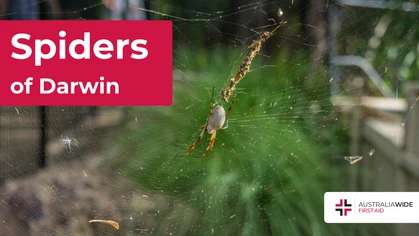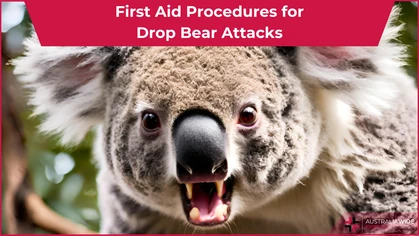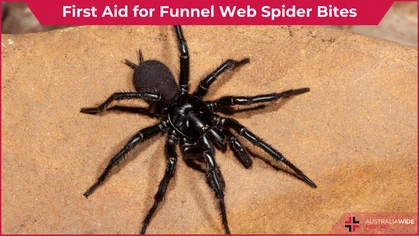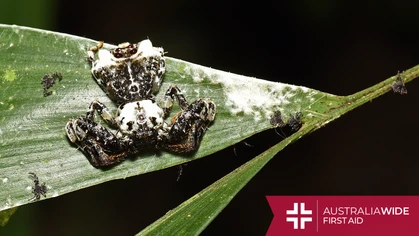Redback Spider Bite

Bites and Stings

Redback Spiders are found across Australia in warm, sheltered sites. They are known for their distinct red stripe and venomous bite.
Redback spiders are considered native to Australia and are found across the country. They prefer to build their webs in dry, sheltered sites, and so they are common in close proximity to human habitation. Bites from a female Redback have been known to cause serious illness and even death.What do Redback Spiders Look Like?
Female Redback spiders are typically black in colour, though they can sometimes be brown. Their most distinctive feature is a red or orange stripe on the top of their abdomen. Male Redback spiders, meanwhile, are usually light brown in colour with white or yellow markings on their abdomen, as opposed to red or orange ones. Both male and female Redback spiders have an hourglass shaped marking on the underside of their abdomen. This marking tends to be paler in males, compared to females. Male Redback spiders are also much smaller than their female counterparts - they only grow to 5mm, which is modest compared to the female's general size of 1 cm.Where do Redback Spiders Live?
Redback Spiders can be found across Australia wherever there is sufficient food, shelter, and warmth. Due to their predilection for dry, sheltered sites, Redback spiders tend to build their nests close to human habitation in sheds, toilets, and under rocks and junk piles. Their nests typically comprise a funnel-like upper retreat area surrounded by sticky catching threads.How Dangerous are Redback Spiders?
Redback spiders are generally retiring creatures and only bite in defence. And though females have been known to steal prey from other webs, they usually stick to their own webs. To this end, female Redback spiders tend to be more aggressive than their male counterparts. They are also the only ones capable of harming humans - the fangs of male Redback spiders are too small to penetrate human skin. As such, it is unlikely for a human to be bitten by a Redback spider unless one of their body parts, such as a hand, comes into direct contact with a web or a female. The venom from a Redback spider acts directly on the nerves and results in the release and subsequent depletion of neurotransmitters. More than 250 victims of Redback spider bites receive antivenom each year. It is thought that an additional number of envenomations go unreported each year due to the mildness of the symptoms. Redback spider bites can cause serious illness and have resulted in deaths, though no deaths have been reported in Australia since 1955, a year before antivenom was introduced.Looking to get you First Aid knowledge up to date?
We run certified First Aid courses throughout all major Acustralian citys. Find a location near you.

Redback spider bites can cause localised pain around the bite site and, in more severe cases, abdominal pain, shallow breathing, and loss of coordination.
What are the Symptoms of Redback Spider Bites?
Redback spider bites are characterised by intense localised pain, redness, and swelling around the bite site. Other common symptoms of a Redback spider bite include:- Sweating.
- Nausea, vomiting, and abdominal pain.
- Loss of coordination.
- Tenderness in the armpit or groin of the affected limb.
- Rapid, shallow breathing.
How do you Treat a Redback Spider Bite?
- Reassure the casualty and keep them under constant observation.
- Apply a cold compress to the bite site for periods of up to 20 minutes to lessen the pain.
- If the casualty is a young child (under 8 years), a pregnant woman, or if they exhibit any signs of deterioration, call Triple Zero (000) for an ambulance.
- DO NOT use the Pressure Immobilisation Technique, as the venom moves slowly and this will just worsen the pain.
Spider Bites and Anaphylaxis
Some people can have a severe allergic reaction when bitten by a spider. This is called anaphylaxis, a condition that can be fatal in as little as 15 minutes. Symptoms include:- Tightness of the throat from swelling.
- Difficulty breathing.
- Tongue and facial swelling.
- Hoarse voice or difficulty speaking.
- A wheeze or persistent cough.
- Collapse or falling unconscious.
- Becoming pale or floppy (young children).
- Abdominal pain and vomiting.
- Hives, welts, and body redness.
Recommended Resources
If you would like to learn more about providing first aid in the event of a bite or sting, book a First Aid course with us today. We also have articles on what to do if you get stung or bitten by snakes, fire ants, and marine life. And for more details on how to identify and treat bites from some of Australia's deadliest spiders, including White tail spiders, Wolf spiders, and Huntsman spiders, head to our Resource Library. Disclaimer: This article is for informational purposes only. It does not constitute, replace, or qualify as any form of first aid training.
Originally published at
https://www.australiawidefirstaid.com.au/resources/redback-spider-bite
as part of the Australia Wide First Aid Articles Library









